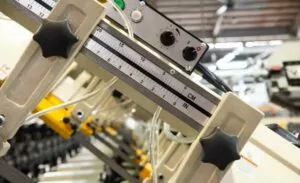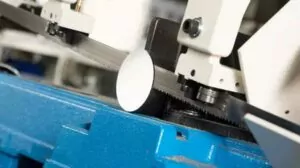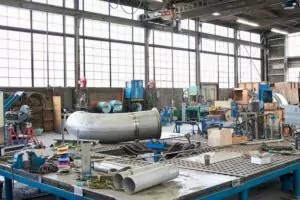The metal bandsaw has revolutionized the metalworking industry since its introduction in the early 20th century. What began as a simple adaptation of woodcutting technology has evolved into a sophisticated, precise, and indispensable tool for metal fabrication across countless industries. Today’s metal bandsaws represent the culmination of decades of engineering refinement, offering unprecedented precision, efficiency, and versatility.
At RongFu, we’ve been at the forefront of metal Band Saw Machine innovation for over 50 years. As an OEM manufacturer based in Taiwan, we’ve produced high-quality machines for leading global brands, giving us unique insights into what makes exceptional metal cutting equipment. Our expertise spans from entry-level hobbyist machines to industrial production systems used in aerospace, automotive, and construction industries worldwide.
In this comprehensive guide, you’ll discover:
- The various types of metal bandsaws and their ideal applications
- Critical components that separate quality machines from inferior options
- How to interpret specifications to make informed purchasing decisions
- Essential selection criteria based on your specific needs
- Best practices for operation, maintenance, and safety
- Emerging technologies shaping the future of metal bandsaws
Whether you’re a hobbyist looking to purchase your first bandsaw or a production manager seeking to optimize your metalworking operations, this guide provides the expert knowledge you need to make informed decisions.
Types of Metal Bandsaws
Metal bandsaws come in various configurations, each designed for specific applications and environments. Understanding these differences is crucial for selecting the right machine for your needs.
Horizontal vs. Vertical Configurations
Horizontal Bandsaws are the workhorses of metal cutting, designed primarily for straight cuts through solid stock. In horizontal operation, the material remains stationary while the saw head moves downward through the cut.
Vertical Bandsaws position the blade vertically, with the workpiece manipulated by the operator on a flat table. This configuration excels at contour cutting, intricate shapes, and precision work.
| Feature | Horizontal Bandsaw | Vertical Bandsaw |
| Primary Use | Straight cuts through stock | Contour cutting, intricate shapes |
| Operation | Material stationary, saw moves | Material moved by operator |
| Floor Space | Generally smaller footprint | Requires more operating space |
| Precision | High precision for straight cuts | High precision for complex cuts |
| Typical Applications | Production cutting, bulk material sizing | Fabrication shops, pattern making |
Manual vs. Semi-Automatic vs. Fully Automatic
The level of automation dramatically impacts productivity and operator involvement:
Manual Bandsaws require the operator to control all aspects of the cutting process, including applying cutting pressure and managing the feed rate. These are typically entry-level machines ideal for shops with occasional cutting needs.
Semi-Automatic Bandsaws automate portions of the cutting cycle. Once set up, the machine will complete a single cut and then return to the starting position, requiring the operator to load new material and initiate each cutting cycle.
Fully Automatic Bandsaws represent the pinnacle of efficiency. These systems handle the entire process, from material feeding to multiple cutting operations, with minimal operator intervention. They often include:
- Automatic material feeding systems
- Multiple cutting programs
- Remnant management
- Self-adjusting cutting parameters
Portable vs. Stationary Models
Portable Bandsaws offer exceptional flexibility, allowing metalworkers to bring cutting capabilities directly to the workpiece. These lightweight units typically sacrifice some cutting capacity and precision for mobility.
Stationary Bandsaws provide superior stability, power, and precision. Their robust construction reduces vibration, resulting in cleaner cuts and longer blade life. Most professional and industrial applications rely on stationary models.
Production-Level Classifications
Metal bandsaws are commonly categorized by their intended duty cycle and capacity:
- Light-Duty: Ideal for hobbyists, small shops, and occasional use. Typically feature smaller motors (½-1 HP) and limited cutting capacities.
- Medium-Duty: Designed for regular use in professional environments. Feature more robust components, larger motors (1-3 HP), and expanded cutting capacities.
- Heavy-Duty: Engineered for continuous operation in production environments. Include powerful motors (3+ HP), premium components, and advanced features for maximum productivity.
Anatomy of a Quality Metal Bandsaw
Understanding the critical components of a metal bandsaw helps discerning buyers identify quality machines that will deliver performance and longevity.
Frame and Construction Materials
The frame serves as the foundation of the entire machine, affecting everything from cut accuracy to vibration damping. Premium metal bandsaws feature frames constructed from:
Cast Iron provides exceptional vibration dampening properties, superior stability, and impressive longevity. High-quality machines often feature cast iron for critical components like the base, tables, and wheel housings.
Steel Construction offers excellent strength-to-weight ratio and is commonly used in structural components. Premium machines utilize heavy-gauge steel with proper reinforcement at stress points.
What separates quality construction:
- Properly reinforced stress points
- Precision-machined mating surfaces
- Powder-coated or industrial paint finishes for corrosion resistance
- Vibration-isolating design elements
Motor Specifications and Power Considerations
The motor serves as the heart of any bandsaw, driving performance and determining the machine’s cutting capabilities. When evaluating a metal bandsaw, understanding the motor specifications is crucial for matching the machine to your application needs.
Most light-duty applications can function effectively with motors ranging from ½ to 1 HP, suitable for occasional use and thinner materials. Medium-duty applications typically require 1-3 HP motors to handle regular operation and more demanding cutting tasks. Industrial and production environments often necessitate powerful 3-5+ HP motors capable of continuous operation and cutting through thick, hardened materials without strain.
Voltage requirements vary based on the machine size and intended environment. Smaller machines typically operate on single-phase power (110V or 220V), making them suitable for smaller shops and hobbyist settings. Larger industrial machines generally require three-phase power, offering more efficient operation for continuous production needs.
Motor type also impacts performance significantly. Traditional induction motors provide reliable service with minimal maintenance, while variable frequency drive (VFD) motors offer superior speed control, allowing operators to fine-tune cutting parameters for optimal results across diverse materials.
Blade Guide Systems
The blade guide system directly impacts cut accuracy and blade life. Superior systems include:
- Precision ball-bearing guides that minimize friction
- Carbide-faced guide blocks for extended life
- Micro-adjustable alignment systems
- Quick-change mechanisms for efficient blade replacement
- Adequate coolant delivery to guide areas
Coolant Systems
When cutting metal, coolant serves multiple critical functions:
- Heat Reduction: Prevents work-hardening of materials and extends blade life
- Chip Removal: Flushes metal particles from the cut
- Lubrication: Reduces friction between the blade and material
Professional-grade bandsaws feature:
- High-capacity coolant reservoirs
- Filtration systems to extend coolant life
- Adjustable flow controls for optimal application
- Properly positioned nozzles for efficient delivery
Control Systems and Interfaces
Today’s premium bandsaws feature intuitive digital speed displays that allow operators to precisely monitor and adjust cutting parameters. This precision ensures optimal blade performance across various materials and cutting conditions. On automated machines, programmable cutting cycles enable operators to set up complex cutting sequences and then let the machine execute them with consistent accuracy, dramatically improving productivity and reducing operator fatigue.
Advanced bandsaws also incorporate material detection sensors that automatically adjust cutting parameters based on the workpiece. These intelligent systems can recognize material changes and modify blade speed and feed pressure accordingly, extending blade life and improving cut quality. Pressure and feed rate controls provide fine-tuning capabilities, allowing operators to achieve the perfect balance between cutting speed and surface finish quality.
Critical Safety Features
Quality manufacturers prioritize operator safety through comprehensive protective features. Modern bandsaws incorporate automatic blade break detection systems that immediately stop operation if a blade failure occurs, preventing potential injuries and damage. These safety systems work alongside accessible emergency stop mechanisms positioned for quick operator access in critical situations.
Physical safeguards such as blade guards and wheel covers provide essential protection against moving components, while sophisticated interlock switches prevent machine operation when these guards are removed for maintenance. Proper electrical protection and grounding complete the safety package, protecting both operators and equipment from electrical hazards.
For a complete overview of safety considerations when operating your metal bandsaw, refer to our comprehensive guide on Health & Safety Tips For Your Metal Band Saw.
Key Performance Specifications Explained
Making sense of bandsaw specifications is essential for selecting the right machine for your needs.
Cutting Capacity Interpretations
Cutting capacity refers to the maximum size of material the bandsaw can accommodate. This is typically specified in several dimensions:
Round Stock Capacity: The maximum diameter of round material the saw can cut.
Rectangular Capacity: Often expressed as width × height (e.g., 7″ × 12″), indicating the maximum dimensions of rectangular stock.
Angular Cutting Capacity: The maximum dimensions when cutting at various angles, usually specified at common angles like 45° and 60°.
Pro Tip: Manufacturers sometimes list optimal cutting capacities rather than maximum capacities. For production environments, it’s advisable to select a machine with capacities 20-30% larger than your typical workpiece size.
Blade Dimensions and Compatibility
Blade dimensions affect both cutting capacity and precision:
- Blade Width: Wider blades provide straighter cuts but limit the minimum radius for contour cutting
- Blade Thickness: Thicker blades offer stability but require larger wheels
- Blade Length: Determined by the specific machine model and must be precise
Before purchasing a bandsaw, understand the availability and cost of compatible blades, especially for specialized applications.
Power Requirements and Electrical Specifications
Proper electrical service is essential for bandsaw operation:
- Voltage: Typically 110V/220V for smaller machines, 220V/440V for industrial units
- Phase: Single-phase for hobbyist/light commercial, three-phase for industrial applications
- Amperage Draw: Ensures your electrical service can support the machine
- Control Voltage: Usually 24V or 110V for safety
Footprint and Workspace Planning
Consider the complete operational footprint, including:
- Base dimensions of the machine
- Additional space needed for material handling
- Clearance for maintenance access
- Operator working space
- Material infeed and outfeed areas
Selecting the Right Metal Bandsaw
Choosing the perfect metal bandsaw requires balancing numerous factors against your specific requirements and constraints. Our guide on How to choose a band saw provides detailed insights, but here are the essential considerations:
Matching Machine Specifications to Your Application
Begin by analyzing your typical cutting needs:
- Material Types: Different metals require specific blade types and cutting speeds
- Typical Material Sizes: Determine your most common cutting dimensions
- Cut Complexity: Straight cuts vs. contours and complex shapes
- Production Volume: Occasional use vs. continuous operation
- Precision Requirements: Tolerance needs for your application
Hobbyist vs. Professional Requirements
The needs of hobbyists and professional operations differ substantially, influencing the features and specifications required in a metal bandsaw.
Hobbyist and small shop environments typically prioritize machines that offer good value while fitting into limited spaces. These users often seek versatile machines capable of handling a variety of projects rather than specialized equipment. For the hobbyist, ease of maintenance and straightforward operation take precedence over advanced features, as these machines may see intermittent use across diverse applications. The initial investment is usually a primary consideration, with many hobbyists preferring to start with more affordable options that can be upgraded or replaced as skills and needs evolve.
In contrast, professional and industrial environments demand machines engineered for reliability under continuous operation. These settings require enhanced precision and repeatability to maintain consistent quality across production runs. Professional-grade bandsaws feature robust construction with premium materials designed to withstand years of heavy use. Automation capabilities become increasingly important as labor costs rise, with features that reduce operator intervention while increasing throughput. Safety features in professional environments must account for multiple operators and higher operational tempos, often incorporating more sophisticated protection systems.
Budget Considerations and ROI Analysis
When evaluating metal bandsaws, consider the total cost of ownership:
- Initial Purchase Price: Including delivery and installation
- Operational Costs: Power consumption, coolant, and consumables
- Maintenance Expenses: Regular service requirements and typical repair costs
- Blade Costs: Ongoing blade replacement based on your cutting volume
- Productivity Impact: Labor savings from automation or improved capacity
For professional applications, calculate the return on investment (ROI) by comparing these costs against the productivity gains and output quality improvements.
Future-Proofing Your Purchase
Investing in a metal bandsaw represents a significant commitment, and planning for future needs can prevent premature replacement costs. Smart buyers look beyond immediate requirements to ensure their equipment remains valuable as their operations evolve.
Begin by selecting a machine with capacity that exceeds your current needs by approximately 25-30%. This buffer accommodates business growth and allows you to take on larger projects without immediately outgrowing your equipment. While this approach may increase initial costs, it typically proves more economical than replacing an undersized machine after just a few years.
Consider models designed with upgrade potential in mind. Some manufacturers offer machines with modular designs that can accept retrofittable automation options or enhanced control systems as your needs change. These upgradeable platforms provide an excellent middle ground between current budget constraints and future capability requirements.
The manufacturer’s track record for supporting older models should factor heavily into your decision. Investigate how long the company typically provides parts and service for discontinued models. A company with a history of long-term support provides valuable insurance for your investment, even if their initial purchase price may be slightly higher.
Replacement part availability and standardization can dramatically impact long-term ownership costs. Some manufacturers use proprietary components that can be expensive and difficult to source, while others incorporate standardized parts available from multiple suppliers. This difference becomes increasingly important as machines age beyond warranty periods.
New vs. Used Considerations
The used equipment market offers potential savings, but requires careful evaluation:
Advantages of New Equipment:
- Warranty protection
- Latest technology and safety features
- Known maintenance history
- Dealer support and training
- Exact specification matching
Used Equipment Considerations:
- Inspection of critical components
- Evaluation of frame alignment and wear
- Assessment of electrical systems
- Availability of replacement parts
- History of maintenance and repairs
Metal Bandsaw Blades
The blade is arguably the most critical component affecting cut quality, speed, and overall productivity. For more detailed information, check our guide on How to Choose a Metal Cutting Bandsaw Blade.
Blade Materials and Construction
Carbon Steel Blades:
- Most economical option
- Suitable for non-ferrous metals and wood
- Limited heat resistance
- Shorter lifespan when cutting harder materials
Bi-Metal Blades:
- High-speed steel teeth welded to flexible carbon steel backing
- Excellent balance of performance and cost
- Good heat resistance
- Suitable for a wide range of materials
- Industry standard for most metal cutting applications
Carbide-Tipped Blades:
- Premium option with tungsten carbide teeth
- Superior heat and wear resistance
- Exceptional cutting speeds and blade life
- Ideal for production environments
- Higher initial cost offset by longer service life
Tooth Design and Patterns
Various tooth configurations serve specific purposes:
- Standard/Regular Tooth: Evenly spaced teeth for general-purpose cutting
- Skip Tooth: Widely spaced teeth that excel at cutting thicker materials and preventing chip clogging
- Hook Tooth: Aggressive cutting angle for faster material removal in softer materials
- Variable Pitch: Teeth with varying spacing to reduce vibration and noise
Pitch and TPI Selection Guidelines
Teeth Per Inch (TPI) selection is critical for effective cutting:
| Material Thickness | Recommended TPI |
| < 1/8″ | 18-32 |
| 1/8″ – 1/4″ | 14-18 |
| 1/4″ – 1/2″ | 10-14 |
| 1/2″ – 3″ | 6-10 |
| > 3″ | 2-6 |
The 3-Tooth Rule: For optimal cutting, at least three teeth should be engaged in the material at all times. Too few teeth can cause tooth stripping; too many can lead to inefficient cutting and premature blade wear.
Blade Width and Thickness Considerations
Blade Width affects:
- Straight cutting capability (wider blades cut straighter)
- Minimum radius for contour cutting (narrower blades can cut tighter curves)
- Overall blade stability during cutting
Blade Thickness impacts:
- Blade rigidity and resistance to twisting
- Wheel diameter requirements
- Heat dissipation capabilities
Specialized Blades for Different Materials
Modern manufacturers offer specialized blades optimized for specific materials:
- Aluminum-specific blades: Features specialized tooth geometry and coatings to prevent material buildup
- Stainless steel blades: Designed to manage the work-hardening properties of stainless
- Exotic alloy blades: Engineered for difficult-to-machine materials like titanium and Inconel
Operation and Best Practices
Proper operation not only improves cut quality but also extends the life of your equipment. For detailed information on blade installation, see our guide on How To Install & Adjust A Metal Band Saw Blade.
Proper Setup Procedures
A thorough setup process ensures optimal performance:
- Blade Selection: Choose the appropriate blade type and TPI for your material
- Blade Tension: Apply the manufacturer’s recommended tension for the blade width
- Guide Adjustment: Position guides as close to the workpiece as practical
- Tracking Adjustment: Ensure the blade runs centered on the wheels
- Speed Selection: Set the appropriate blade speed for the material being cut
- Coolant Preparation: Verify coolant concentration and flow
Feed Rate and Pressure Adjustments
Proper feed rate and pressure are critical for both cut quality and blade life:
- Too Fast: Causes premature blade wear and poor cut quality
- Too Slow: Results in inefficient cutting and potential work hardening
- Optimal Setting: Produces consistent, curled chips without excessive heat
On manual machines, operators develop a feel for proper pressure through experience. Automatic machines typically offer adjustable hydraulic feed control systems.
Coolant Use and Management
Effective coolant management includes:
- Maintaining proper concentration (typically 5-10% for synthetic coolants)
- Regular filtration to remove metal particles
- Monitoring for bacterial growth and pH changes
- Applying coolant directly to the cutting area
- Maintaining adequate coolant levels
Common Cutting Techniques
Mastering these techniques improves results across applications:
Straight Cutting:
- Ensure material is securely clamped
- Use the appropriate blade tension
- Apply consistent feed pressure
- Maintain adequate coolant flow
Contour Cutting (Vertical Bandsaws):
- Select the appropriate blade width for your minimum radius
- Use relief cuts for tight internal corners
- Maintain consistent feed rate around curves
- Support the material properly on the table
Notching and Slotting:
- Use relief cuts at corners
- Consider pre-drilling for internal cuts
- Employ backup material to prevent burrs on the exit side
Troubleshooting Common Cutting Problems
For more detailed troubleshooting assistance, refer to our guide on Troubleshooting Your Metal Band Saw. Here are some common issues and solutions:
| Problem | Possible Causes | Solutions |
| Premature Blade Failure | Excessive speed, Inadequate coolant, Improper tension | Reduce speed, Increase coolant flow, Adjust tension |
| Poor Cut Accuracy | Dull blade, Insufficient tension, Improper guide adjustment | Replace blade, Correct tension, Adjust guides |
| Excessive Noise | Worn guides, Improper blade speed, Loose components | Replace guides, Adjust speed, Tighten fasteners |
| Rough Cut Finish | Incorrect TPI for material, Excessive feed rate, Inadequate coolant | Change blade, Reduce feed rate, Increase coolant |
| Motor Overheating | Electrical issues, Excessive load, Ventilation problems | Check wiring, Reduce feed pressure, Improve airflow |
Maintenance and Care
Proper maintenance extends machine life and ensures consistent performance. Develop a structured maintenance program based on usage frequency and cutting volume.
Maintenance Scheduling for Optimal Performance
Implementing a structured maintenance program is essential for maximizing the performance and lifespan of your metal bandsaw. The frequency and depth of maintenance should correspond to your operational intensity and cutting volume.
Daily maintenance forms the foundation of proper bandsaw care. At the end of each shift, operators should thoroughly clean all machine surfaces and remove accumulated chips that could interfere with operation or precision. Coolant systems require daily attention, with checks of both level and concentration to ensure optimal cutting conditions. A quick inspection of the blade for signs of wear or damage can prevent unexpected failures during critical operations. Guide alignment should be verified daily, as even minor misalignments can significantly impact cut quality and blade life. Finally, cleaning filters and chip removal systems prevents buildup that could affect coolant flow and machine performance.
Weekly maintenance extends to components that experience slower wear but still require regular attention. Drive belt tension and condition should be carefully examined, as belts can stretch or develop wear spots that affect power transmission. All fluid levels, including hydraulic systems and gearbox oil, should be checked and topped off as needed. The coolant tank requires a more thorough cleaning weekly, including filtration system maintenance to remove accumulated metal particles. Electrical connections can loosen due to machine vibration and should be inspected for tightness and signs of corrosion. All safety devices deserve special attention during weekly checks to ensure they remain fully functional.
Monthly maintenance addresses deeper preventive measures that support long-term reliability. A complete lubrication of all specified points according to the manufacturer’s guidelines prevents premature wear of moving components. Drive wheels should be closely examined for signs of wear, imbalance, or bearing issues that could affect blade tracking. Hydraulic system components require monthly inspection for leaks, proper pressure, and fluid condition. Machine alignment checks help identify and correct any drift that might have developed from heavy use. Finally, a systematic tightening of all fasteners compensates for the natural loosening that occurs through operational vibration.
Lubrication Points and Procedures
Proper lubrication is essential for longevity:
- Guide Bearings: Lubricate according to manufacturer specifications
- Drive Components: Maintain proper oil levels in gearboxes
- Pivot Points: Apply grease to all pivot points and hinges
- Slides and Ways: Keep clean and properly oiled
- Hydraulic Systems: Check fluid levels and condition regularly
Blade Changing and Tensioning
Proper blade installation and tensioning procedures include:
- Blade Selection: Choose the appropriate blade for your material
- Tension Application: Follow manufacturer guidelines for proper tensioning
- Guide Adjustment: Set guides properly after blade installation
- Break-in Procedure: Gradually introduce new blades to full cutting load
- Tension Relief: Release tension when the machine will be idle for extended periods
Alignment and Calibration Tips
Regular alignment checks ensure optimal performance:
- Verify blade perpendicularity to the table on vertical machines
- Check vise alignment on horizontal machines
- Ensure proper tracking on both wheels
- Confirm accuracy of angle settings with precision measuring tools
- Inspect for proper blade guide alignment
Preventative Maintenance to Extend Machine Life
Proactive maintenance dramatically extends machine life:
- Maintain detailed maintenance records
- Replace wear items before failure
- Address minor issues immediately
- Keep machines clean and free of chips and debris
- Follow manufacturer-recommended service intervals
Safety Considerations
Safe operation of metal bandsaws requires attention to proper procedures, appropriate protective equipment, and ongoing training. While we cannot overstate the importance of safety when operating this powerful equipment, we won’t cover all safety aspects in this article.
For a comprehensive guide to operating your metal bandsaw safely, including detailed information on personal protective equipment, safe operation procedures, emergency protocols, and proper training requirements, please refer to our dedicated resource: Health & Safety Tips For Your Metal Band Saw.
This comprehensive guide covers everything you need to know about maintaining a safe working environment when operating metal bandsaws in both hobbyist and professional settings. We strongly recommend reviewing these guidelines before operating any metal cutting equipment.
Comparing Top Manufacturers
The global bandsaw market includes numerous manufacturers across various price points and quality tiers.
What Separates Premium Brands from Budget Options
Quality differentiators include:
- Material Selection: Premium castings and high-grade steel components
- Manufacturing Precision: Tighter tolerances in critical assemblies
- Testing Standards: Rigorous quality control procedures
- Design Engineering: Purpose-built components vs. generic parts
- Support Infrastructure: Technical service availability and parts supply
How OEM Manufacturing Influences Quality
As an OEM manufacturer with decades of experience, RongFu has unique insights into how manufacturing relationships affect quality:
- Engineering Collaboration: Close work between brands and manufacturers improves designs
- Quality Accountability: Clear standards between OEM and brand ensure consistency
- Scale Advantages: OEM production volumes enable investment in advanced manufacturing technology
- Specialization Benefits: Focused expertise on specific machine types enhances quality
- Global Standards Compliance: OEM manufacturers must meet diverse international requirements
Beyond our metal bandsaws, RongFu also produces high-quality Mill Drill Machines utilizing the same precision manufacturing standards and quality control processes.
Key Differentiators to Consider When Evaluating Brands
When comparing manufacturers, evaluate:
- Manufacturing Facilities: Modern equipment and quality control systems
- Engineering Expertise: Dedicated design teams vs. imported designs
- Service Infrastructure: Availability of technical support and parts
- Warranty Terms: Coverage duration and scope
- User Community: Existing customer satisfaction and long-term experience
- Innovation History: Track record of meaningful improvements vs. superficial changes
Final Words
The metal bandsaw represents an essential investment for any metalworking operation. Selecting the right machine requires careful consideration of your specific needs, production requirements, and budget constraints.
Summary of Key Points
Throughout this guide, we’ve explored:
- The diverse types of metal bandsaws and their optimal applications
- Critical components that determine machine quality and longevity
- Essential specifications that impact performance and capability
- Selection criteria for matching machines to specific requirements
- Best practices for operation, maintenance, and safety
- Emerging technologies shaping the future of metal bandsaw design
Final Advice for Purchasers
As you evaluate metal bandsaws for your operation:
- Prioritize Quality: Invest in the highest quality your budget allows
- Consider Total Cost of Ownership: Look beyond the initial purchase price
- Match to Application: Select a machine tailored to your specific cutting needs
- Value Support: Consider manufacturer and dealer support capabilities
- Plan for Growth: Choose a machine that can accommodate future needs
RongFu’s Manufacturing Philosophy and Commitment to Quality
At RongFu, our 40+ years of manufacturing experience is built on core principles:
- Engineering Excellence: Continuous improvement through innovative design
- Manufacturing Precision: Investment in advanced production technology
- Quality Control: Rigorous testing at every production stage
- Material Selection: Only the highest quality components and materials
- Customer Partnership: Collaboration with brands and end-users to refine designs
As an OEM manufacturer serving premier global brands, we understand that our success depends entirely on the performance and reliability of our machines in real-world applications. Every metal bandsaw that leaves our facility represents our commitment to quality and our passion for precision metalworking.
Whether you’re cutting your first piece of stock or managing a production facility, the right metal bandsaw makes all the difference. We’re proud to play a role in metalworking operations around the world, and we remain committed to advancing bandsaw technology for the next generation of metalworkers.





